Polen |
|
|
|
| Übersicht – Contents: | |
Polen |
|
|
|
| Übersicht – Contents: | |
Flaggen – Flags: |
|
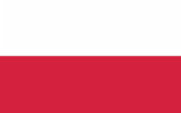 |
National- und Staatsflagge – national and state flag, Seitenverhältnis – ratio = 5:8, Quelle/Source, nach/by: Wikipedia (PL)   |
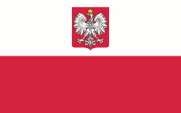 |
Handelsflagge und Staatsflagge mit Wappen – merchant flag and state flag with coat of arms, Seitenverhältnis – ratio = 5:8, Quelle/Source, nach/by: Wikipedia (PL)    |
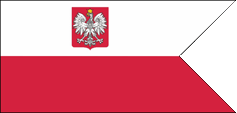 |
Marine- und Kriegsflagge – naval and war flag, Seitenverhältnis – ratio = 10:21, Quelle/Source, nach/by: Wikipedia (PL) |
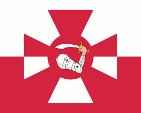 |
seit/since 1993, Gösch – naval jack, Seitenverhältnis – ratio = 4:5, Quelle/Source, nach/by: Wikipedia (PL) |
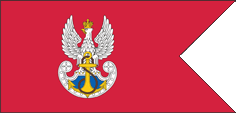 |
Flagge der Marine – flag of the Navy, Seitenverhältnis – ratio = 10:21, Quelle/Source, nach/by: Wikipedia (PL), using: Naval_Ensign_of_Poland2.svg: Mboro, Public domain, via Wikimedia Commons |
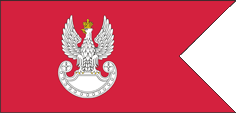 |
Flagge des Heeres – flag of the Army, Seitenverhältnis – ratio = 10:21, Quelle/Source, nach/by: Wikipedia (PL), using: Kpalion, Public domain, via Wikimedia Commons |
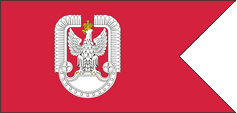 |
Flagge der Luftwaffe – flag of the Air Force, Seitenverhältnis – ratio = 10:21, Quelle/Source, nach/by: Wikipedia (PL), using: POL_Wojska_Lotnicze.svg: Poznaniak: Mboro, Public domain, via Wikimedia Commons |
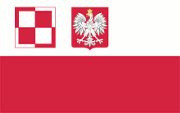 |
Flagge der Flugplätze der Luftwaffe – flag of the Air Force air fields, Seitenverhältnis – ratio = 5:8, Quelle/Source, nach/by: Wikipedia (PL) |
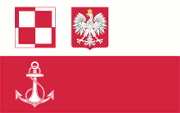 |
Flagge der Flugplätze der Marine – flag of the Navy air fields, Seitenverhältnis – ratio = 5:8, Quelle/Source, nach/by: Wikipedia (PL) |
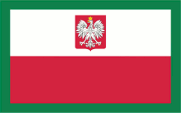 |
Flagge Grenzschutz – flag of the border patrol, Seitenverhältnis – ratio = 5:8, Quelle/Source, nach/by: Wikipedia (PL) |
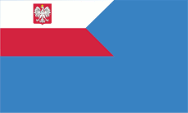 |
Flagge der Hilfsschiffe – flag for aux ships, Seitenverhältnis – ratio = 3:5, Quelle/Source, nach/by: Wikipedia (PL) |
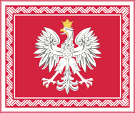 |
seit/since 1990, Flagge Staatspräsident – flag of the President, Seitenverhältnis – ratio = 5:6, Quelle/Source, nach/by: Flags of the World |
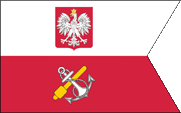 |
Flagge Verteidigungsminister – flag of the Minister of Defence, Seitenverhältnis – ratio = 5:8, Quelle/Source, nach/by: Wikipedia (PL) |
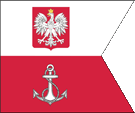 |
Flagge Oberbefehlshaber der Marine – flag of the Supreme Commander of the Navy, Seitenverhältnis – ratio = 5:6, Quelle/Source, nach/by: Wikipedia (PL) |
historische Flaggen – historical Flags: |
|
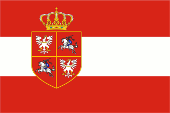 |
1569–1795, |
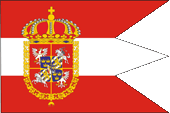 |
1587–1648, |
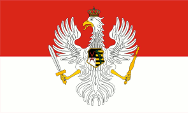 |
1697–1763, |
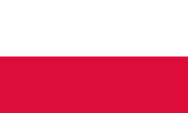 |
1807–1815, |
 |
1815–1846, |
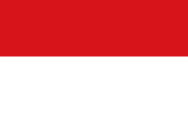 |
1815–1886, |
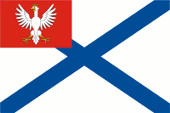 |
1815–1831, |
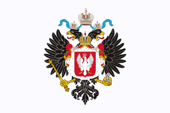 |
1815–1830, |
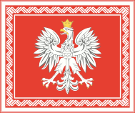 |
1928–1939, Flagge Staatspräsident – flag of the President, Seitenverhältnis – ratio = 5:6, Quelle/Source, nach/by: Flags of the World |
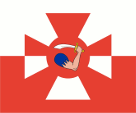 |
1919–1939,
1955–1980, (in Zinnoberrot / Vermilion), Gösch – naval jack, Seitenverhältnis – ratio = 5:6, Quelle/Source, nach/by: Wikipedia (PL) |
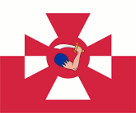 |
1980–1993, (in Purpurrot / Crimson), Gösch – naval jack, Seitenverhältnis – ratio = 5:6, Quelle/Source, nach/by: Wikipedia (PL) |
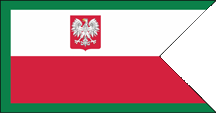 |
1980–1990, (1953–1980 in Zinnoberrot / Vermilion), Flagge des Militärischen Grenzschutzes – flag of the Border Defence Forces, Seitenverhältnis – ratio = 10:21, Quelle/Source, nach/by: Wikipedia (PL) |
| Die Flagge Polens zeigt zwei horizontale Streifen in Weiß und Rot. Die Farben gehen auf die polnische Heraldik (weißer Adler auf rotem Grund) zurück. Sie wurde am 05.11.1916 eingeführt, jedoch wurde sie schon im 19. Jahrhundert bei nationalen Erhebungen gezeigt. | The flag of Poland shows two horizontal stripes in white and red. The colours have its roots in the Polish heraldry (white eagle on red ground). It was introduced on 5th of November in 1916, but it was already used in the 19th century at national uprisings. |
| Die
Anfänge der typischen polnischen Heraldik mit dem weißen Adler auf rotem
Grund liegen weitestgehend im Dunklen. Wahrscheinlich orientierte sich die Heraldik an den Farben des Frankenreichs und mit dem Adler an der Symbolik des Römischen Reichs. |
The beginning of the typical Polish heraldry with the white eagle on red ground is nearly complete hide in the past. Probably was this heraldry orientated – with the using of that colours – in the Frankish Empire and – with the using of the eagle – in the symbolism of the Roman Empire. |
| Der Adler taucht erstmals auf Münzen um das Jahr 1000 auf. Urkundlich und als Wappen belegt ist er erstmals im Jahre 1295 auf einer Urkunde des Königs Przemyslaw II. Andere Quellen nennen auch die Jahre 1228 und 1241. | The eagle appears for the first time on coins about the year 1000. Documentary and proved as coat of arms is it for the first time in the year 1295 on a deed of King Przemyslaw II. Other sources name also the years 1228 and 1241. |
| In der Zeit des Wahlkönigtums, vom 16. bis zum 18. Jahrhundert, bestimmte die jeweilige Dynastie das Aussehen der Flagge Polens; meist Streifenflaggen in den Farben Rot und Weiß, oder rote Flaggen mit dem polnischen Adler. | In the time of the elective monarchy - from the 16th to the 18th century - each dynasty decided over the appearance of the flag of Poland, mostly flags with stripes in the colors red and white, or red flags with the Polish eagle. |
|
Interessant ist die Flagge von Sachsen-Polen, eine Periode in der das
Königreich Polen von den sächsischen Kurfürsten regiert wurde: 1697–1704,
1709–1733, 1733–1763. Die Flagge zeigte zwei Streifen in Rot und Weiß, und
in der Mitte einen Polnischen Adler mit dem kursächsischen Wappen als
Brustschild (für Details: Die Flagge von Sachsen-Polen). |
Interesting is the flag of Saxony-Poland, a period in which the Kingdom of
Poland was ruled by the Saxon electors: 1697-1704, 1709-1733, 1733-1763. The flag showed two stripes in red and white, and in the middle a Polish eagle with the Saxon electoral coat of arms as a breastplate (For details: Die Flagge von Sachsen-Polen). |
| Der polnische Staat endete im Jahre 1795 mit der letzten Polnischen Teilung, als Polen zwischen Russland, Österreich und Preußen aufgeteilt wurde. Nachdem Napoléon in der Region einmarschiert war (1806), hat er im Jahre 1807 das Herzogtum Warschau geschaffen, welches bis 1815 unter Sächsischer Krone bestand. Es verwendete eine Flagge welche zwei horizontale Streifen in Weiß und Purpurrot zeigte. | The
Polish state finished in the year 1795 with the last Polish Division as
Poland became divided between Russia, Austria and Prussia. After Napoléon invaded that region (1806) he created the Duchy of Warsaw in the year 1807 which existed until 1815 under Saxon crown. It used a flag which showed two horizontal stripes in white and crimson. |
| Das Herzogtum Warschau wurde mit dem Ende der Ära Napoléon zum Wiener Kongress (29.03.1815) zwischen Preußen, Russland und dem Freistaat Krakau aufgeteilt. Der preußische Teil wurde das Herzogtum Posen, welches in seinem Wappen den polnischen Adler im Brustschild des preußischen Adlers zeigte, sowie eine Flagge mit zwei horizontalen Streifen in Rot und Weiß verwendete. Der russische Teil nannte sich zwar "Königreich Polen", wurde aber als "Kongress-Polen" bekannt. Der König war der russische Zar und das Land nicht mehr als eine russische Provinz. Der Freistaat Krakau (auch Republik Krakau) war nur etwa 400 km² groß. Er verwendete bis zu seiner Annektierung durch Österreich im Jahre 1846 eine Flagge welche zwei horizontale Streifen in Weiß und Blau zeigte. | The Duchy
of Warsaw became with the end of the era Napoléon divided between Prussia,
Russia and the Free State of Krakau on the occasion of the Vienna Congress
(29th of March 1815). The Prussian part became the Duchy of Posen which showed in its coat of arms the Polish eagle in the chest shield of the Prussian eagle, as well as a flag with two horizontal stripes in red and white. The Russian part was indeed called "Kingdom of Poland", but became known as "Congress Poland". The king was the Russian tsar and the country was not more then a Russian province. The Free State of Krakau (also Republic of Krakau) has only an area of ca. 155 sq.mi. It used until its annexation by Austria in the year 1846 a flag which showed two horizontal stripes in white and blue. |
| Im Verlauf des Ersten Weltkrieges (1914–1918) wurde das russische Polen durch deutsche und österreichisch-ungarische Truppen erobert. Die russische Herrschaft endete hier am 05.08.1915 und am 05.11.1916 wurde das Regentschaftskönigreich Polen proklamiert und eine Flagge angenommen welche zwei horizontale Streifen in Weiß und Rot zeigte. Erst 1917 wurde der polnische Staat durch die Entente (Großbritannien, Frankreich, Italien, USA) anerkannt. Am 07.11.1918 wurde in Lublin die Republik Polen proklamiert und die seit 1916 verwendete Flagge beibehalten. | During
the First World War (1914–1918) Russian Poland was conquered by German and
Austrian-Hungarian troops. The Russian rule ended here on the 5th of August
in 1915 and on the 5th of November in 1916 was proclaimed the Regency
Kingdom of Poland and it was adoped a flag which showed two horizontal
stripes in white and red. By the Entente (Great Britain, France, Italy, USA) the Polish state was recognized not until 1917. On 7th of November in 1918 in Lublin was proclaimed the Republic of Poland and the since 1916 used flag became continued. |
| Zu Beginn
des Zweiten Weltkriegs (1939–1945) wurde Polen in nur 26 Tagen durch
deutsche (ab 01.09.) und sowjetrussische Truppen (ab 17.09.) überannt und
musste am 27.09.1939 kapitulieren. Der Staat Polen endete und wurde zwischen
der Sowjetunion und dem Deutschen Reich aufgeteilt. Im Zuge der Besetzung durch die Sowjetunion wird am 01.01.1945 in Lublin eine polnische Regierung gebildet, und die Flagge von 1916 offiziell wieder eingeführt, und am 20.03.1956 nochmals bestätigt. |
In the beginning of the Second World War (1939–1945) Poland became overruned in only 26 days by German (since 1st of Sept.) and Soviet Russian troops (since 17th of Sept.) and has to capitulate on 27th of September in 1939. The State of Poland ended and became divided between the Soviet Union and the German Empire. On the occasion of the occupation by the Soviet Union in Lublin was established on 1th of January in 1945 a Polish government and the flag of 1916 became officially re-introduced and confirmed on 20th of March in 1956. |
| Quelle/Source: Flaggen und Wappen der Welt, Die Welt der Flaggen, Flaggen Enzyklopädie, Volker Preuß | |
|
|
|
| Der rote Farbton war anfänglich nicht genau definiert. Im Jahre 1921 wurde vom polnischen Militär die Broschüre "Wappen und Flagge der Republik Polen" herausgegeben, die das Rot erstmals als Purpurrot bezeichnete, jedoch ohne eine Norm zu hinterlegen. Im Jahre 1928 legte der Präsident fest, dass das Rot Zinnoberrot zu sein habe, jedoch wieder ohne eine Norm zu hinterlegen. Am 31.01.1980 wurde der Farbton erstmals exakt definiert, und zwar nach CIE, als x = 0.570, y = 0.305, Y = 16.0, ΔE = 8.0 und kommt somit dem bis 1928 verwendeten Farbton wieder nahe. |
The shade of red was
initially not precisely defined. In 1921, the Polish military published the
brochure "Coat of Arms and Flag of the Republic of Poland", which for the
first time referred to the red as crimson, but without laying down a
standard. In 1928, the President specified that the red was to be vermilion, but again without depositing a standard. On 31.01.1980, the shade was defined exactly for the first time, according to CIE, as x = 0.570, y = 0.305, Y = 16.0, ΔE = 8.0 and thus comes close again to the shade used until 1928. |
| Quelle/Source: Wikipedia (DE) | |
|
|
|
 Bild/Pic.: Volker Preuß |
|
Wappen – Coat of Arms: |
|
 |
seit/since 1990, Wappen von Polen – coat of arms of Poland, Quelle/Source, nach/by: Corel Draw 4 |
historische Wappen – historical Coats of Arms: |
|
 |
ca.1000–1386 / 1569–1795, Wappen von Polen – coat of arms of Poland, Quelle/Source, nach/by: Wikipedia (DE) |
 |
1386–1569, Wappen von Polen-Litauen – coat of arms of Poland-Lithuania, Quelle/Source, nach/by: Wikipedia (DE) |
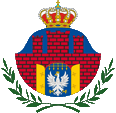 |
1815–1846, Wappen Freistaat Krakau – coat of arms of the Free State of Krakau, Quelle/Source, nach/by: Wikipedia (PL) |
 |
1815–1832, Kongress-Polen – Congress Poland, Wappen Königreich Polen – coat of arms of the Kingdom of Poland, Quelle/Source, nach/by: Wikipedia (PL) |
 |
1916–1918, Regentschaftskönigreich Polen – Regency Kingdom of Poland, Wappen Königreich Polen – coat of arms of the Kingdom of Poland, Quelle/Source, nach/by: Wikipedia (PL) |
 |
1919–1927, Wappen von Polen – coat of arms of Poland, Quelle/Source, nach/by: Wikipedia (PL) |
 |
1927–1939, Wappen von Polen – coat of arms of Poland, Quelle/Source, nach/by: Wikipedia (PL) |
 |
1944–1980, Wappen von Polen – coat of arms of Poland, Quelle/Source, nach/by: Wikipedia (PL) |
 |
1980–1990, Wappen der Volksrepublik Polen – coat of arms of People's Republic of Poland, Quelle/Source, nach/by: Wikipedia (DE) |
| Das Staatswappen Polens zeigt einen golden bewehrten silbernen Adler auf rotem Feld. Diese polnische Heraldik hat eine lange Tradition, und ist als Wappen erstmalig im Jahre 1295 auf einer Urkunde des Königs Przemyslaw II. nachgewiesen. Andere Quellen nennen auch das Jahr 1241 oder eine Darstellung ohne Farben aus dem Jahr 1228. Einige Münzen lassen die Verwendung des Adlers auch schon um das Jahr 1000 vermuten. Nach dem Ende Polens im Jahr 1795 wurde die polnische Heraldik im Jahre 1916 wiederbelebt. Das Wappen wurde 1927 modernisiert und entsprach damals schon fast genau dem heutigen Aussehen. Nach dem Ende des Zweiten Weltkriegs und der Restauration Polens wurden im Jahre 1945 die alten Staatssymbole wieder eingeführt. Durch den starken Einfluss der Sowjetunion bedingt, wurde Polen ein sozialistischer Staat. So kam es, dass im Jahre 1952 die Krone vom Kopf des Adlers entfernt wurde. Nach dem Ende des Sozialismus wurde die Krone im Jahre 1990 dem Adler wieder auf das Haupt gesetzt. | The coat
of arms of Poland shows a golden armed silvery eagle on red field. That
Polish heraldry has a long tradition and is proved as coat of arms for the
first time in the year 1295 on a deed of King Przemyslaw II. Other sources
name also the year 1241 or a portrayal without colours from the year 1228.
Some coins keep suppose the use of the eagle even already about the year
1000. After the
end of Poland in the year 1795 the Polish heraldry was revitalized in the
year 1916. The coat of arms became modernized in 1927 and complyed at that
time already nearly exact with the today’s design. After the end of the
Second World War and the restoration of Poland were re-introduced the old
symbols of the state in 1945. Involved by the potent influence of the Soviet
Union Poland became a socialistic state. In this way occurs that in 1952 the
crown was removed from the head of the eagle. After the end of the socialism
the crown was put on the haed of the eagle again in 1990. |
| Quelle/Source: Flaggen und Wappen der Welt, Die Welt der Flaggen, Flaggen Enzyklopädie, Volker Preuß | |
Flugzeugkokarde – aircraft roundel: |
|
 |
Flugzeugkokarde – aircraft roundel Quelle/Source, nach/by: Wikipedia (EN) |
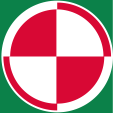 |
Flugzeugkokarde für den Grenzschutz – aircraft roundel for the Border Guard Quelle/Source, nach/by: Wikipedia (EN) |
 |
1921–1993 Flugzeugkokarde – aircraft roundel Quelle/Source, nach/by: Wikipedia (EN) |
Landkarte – Map: |
Lage – Position: |
Landkarte des Landes – Map of the Country: |
|
|
| Zahlen und Fakten – Numbers and Facts: | |
|
|
|
|
|
|
|
|
|
|
|
|
|
|
|
|
|
|
|
|
|
|
4. bis 2. Jahrhundert v. Chr. · Besiedlung des heutigen Polens duch
germanische (Goten, Burgunder, Vandalen, Lugier) und baltische Völker
(Pruzzen, Litauer, Liven, Kuren), slawische Stämme besiedeln das Gebiet der
heutigen Ukraine und Weißrusslands 4. bis 6. Jahrhundert · Völkerwanderung, durch die Ausbreitung der Hunnen in Mittelasien werden ganze Völkerschaften nach Westen gedrängt, die Hunnen schieben die Slawen vor sich her, und diese die Germanen 6. bis 7. Jahrhundert · massive Einwanderung slawischer Stämme (Polanen, Masowier, Wislanen, Pomoranen) in die germanisch besiedelten Gebiete des heutigen Polens, die Germanen wandern in Richtung Westen ab ca.800–ca.900 · Herausbildung des Wislanischen Fürstentums Krakau und des Polanischen Fürstentums Gnesen ca.960 · Mieszko I. aus dem Haus der Piasten wird Herzog der Polanen ca. 1000 · Boleslaw I. aus dem Haus der Piasten erobert das heutige Südpolen 1119 · Boleslaw III. aus dem Haus der Piasten erobert Pommerellen 1122 · Boleslaw III. aus dem Haus der Piasten erobert Pommern 1138 · Erbfolgekrieg nach dem Tode von Boleslaw III., Zerfall Polens in unabhängige Herzogtümer, beginnende Besiedlung durch Deutsche Bauern, Balten dringen von Norden her ein 1241 · Schlacht bei Liegnitz, Niederlage eines polnisch-deutschen Heeres unter Herzog Heinrich II. von Niederschlesien gegen die Mongolen, Balten dringen von Norden her tiefer in das Land ein 1226 · Konrad Herzog von Masowien ruft den Deutschen Orden zur Abwehr der Balten ins Land 1276 · Przemysl II. vereint die Herzogtümer von Posen, Gnesen und Kalisch und wird Herzog von Groß-Polen 1295 · Przemysl II. wird in Gnesen zum polnischen König gekrönt 1309 · der Deutsche Orden besetzt Pommerellen und die Stadt Danzig 1327 · Schlesien wird böhmisches Lehen 1370 · das Geschlecht der Piasten stirbt mit Kasimir III. im Königreich Polen aus 1370 · Ludwig I., König von Ungarn, wird König von Polen 1386 · Hedwig (Jadwiga), Tochter von Ludwig I. König von Ungarn und Polen, heiratet den litauischen Großfürsten Jagiello und begründet die polnisch-litauische Personalunion und das Geschlecht der Jagiellonen 1410 · Schlacht bei Tannenberg, Niederlage des Deutschen Ordens gegen Polen-Litauen, dadurch Verhinderung einer weiteren Ausdehnung des Deutschen Ordens nach Litauen hinein 1411/1466 · Thorner Frieden, der Deutsche Orden tritt Pommerellen, das Kulmer Land, Westpreußen und das Ermland an Polen-Litauen ab 1440 · Wladyslaw III., König von Polen-Litauen wird König von Ungarn 1471/1490 · Kasimir IV., König von Polen-Litauen, erwirbt die Kronen Böhmens und Ungarns 29.08.1526 · Türkenschlacht bei Mohács, Tod von Ludwig II., Böhmen und Ungarn kommen an das Haus Habsburg 1569 · Lubliner Union, Polen und Litauen, bisher in Personalunion werden vereinigt 07.07.1572 · Tod von Sigismund II. August, dem letzten Jagiellonen, der Reichstag (Sejm) erwirbt das Recht zur Wahl des Königs 1573 · Wahl von Heinrich aus dem französischen Hause Valois zum König von Polen 1576 · Wahl von Stefan aus dem ungarischen Hause Báthory zum König von Polen 1587 · Wahl von Sigismunds III. aus dem schwedischen Hause Wasa zum König von Polen 1632 · Wahl von Wladyslaws IV. aus dem schwedischen Hause Wasa zum König von Polen, in der Folgezeit Kriege gegen Schweden, Russland und das Osmanische Reich 1648 · ukrainischer Kosakenaufstand unter Bogdan Chmielnizki, Sturz von König Wladyslaw IV., die Ukraine löst sich von Polen und verbindet sich mit Russland 1697 · Wahl des Kurfürsten August II. (der Starke) von Sachsen zum König von Polen 1700–1721 · Nordischer Krieg, Dänemark, Sachsen, Polen, Rußland, Preußen, Hannover gegen Schweden, Polen ist häufig Kriegsschauplatz und wird verwüstet, muss Livland an Russland abtreten und Ostpreußen wird ein Lehen Brandenburgs 1733 · Tod von König August II., in der Folgezeit Wahlen neuer Könige, Kriege gegen das Osmanische Reich um die Ukraine und Podolien, Verluste und Niederlagen, politischer, wirtschaftlicher und kultureller Verfall 1764–1795 · Regentschaft von König Stanislaus II. August Poniatowski, wachsender russischer Einfluss 1772 · Erste Polnische Teilung, um dem wachsenden russischen Einfluss im Polnischen Staat entgegenzuwirken, sichern Österreich und Preußen weite polnische Gebiete vor dem russischen Zugriff durch deren Annexion, Preußen annektiert Westpreußen, Ermland, Pommerellen (ohne Danzig), das Kulmer Land, das nördliche Kujawien und das Netzegebiet, Österreich annektiert Galizien, die südlichen Teile der Wojewodschaften Krakau und Sandomir, die Wojewodschaft Reussen mit Lemberg, Rußland annektiert alles polnische Territorium östlich der Düna und des Dnjepr, in der Folgezeit erreichen die Zustände im Land eine deutliche Besserung, jedoch ruft die Magnatenkonföderation (Adelsversammlung) von Targowitza im Jahre 1792 russische Hilfe ins Land 1793 · Zweite Polnische Teilung, um erneut dem wachsenden russischen Einfluss im Polnischen Staat entgegenzuwirken, sichert Preußen weitere polnische Gebiete vor dem russichen Zugriff durch deren Annexion, Preußen annektiert Großpolen (Südpreußen) und Danzig, Rußland annektiert die Ukraine, Ost-Polesien und Ost-Wolynien, daraufhin kommt es 1794 zum nationalen Volksaufstand unter Tadeusz Kosciuszko, der sich vor allem gegen die Russen und den pro-russischen Adel richtete, erneuter politischer, wirtschaftlicher und kultureller Verfall 1795 · Dritte Polnische Teilung, um dem weiter wachsenden russischen Einfluss in Polen entgegenzuwirken, sichern Österreich und Preußen wiederum weite polnische Gebiete vor dem russichen Zugriff durch deren Annexion, Preußen annektiert Neuostpreußen (Masowien und Teile Litauens), Österreich annektiert Kleinpolen (West-Galizien), Rußland annektiert alles verliebene polnische Territorium (West-Polesien und West-Wolynien, Litauen und Kurland), die Existenz des polnischen Staats war damit beenedet 1806 · Deutschland-Feldzug von Napoléon I., Niederlage des Deutschen Reiches, Ende des Heiligen Römischen Reiches Deutscher Nation 1807 · Preußen muss die ab 1793 und Österreich die 1795 annektierten Gebiete an das von Napoléon geschaffene Herzogtum Warschau unter König Friedrich August von Sachsen abtreten 1813/1814 · Völkerschlacht bei Leipzig, Ende der Ära Napoléon 29.03.1815 · Wiener Kongress, Neuordnung Europas nach der Ära Napoléon, das Herzogtum Warschau wird aufgelöst. Preußen erhält das Kulmer Land, das Netzegebiet und den westlichen Teil Großpolens (Posen) zurück, Krakau wird Freistaat. Alle übrigen Gebiete des ehemaligen Herzogtums Warschau gehen als "Königreich Polen" (Kongress-Polen) an Russland, Polnischer König ist der Russische Zar, und das Land nicht mehr als eine russische Provinz 1830–1831 · vom polnischen Adel angezettelter polnischer nationalistischer Volksaufstand ("Warschauer Aufstand") in Russisch-Kongresspolen und auch im preußischen Großherzogtum Posen, der Aufstand wird niedergeschlagen, der im preußischen Großherzogtum Posen regierende polnische Adel wird entmachtet und Posen wird in eine preußische Provinz umgewandelt 1846 · vom Freistaat Krakau aus organisiert der entmachtete polnische Adel einen weiteren nationalistischen Volksaufstand im österreichischen Galizien, der Aufstand wird niedergeschlagen, Österreich besetzt und annektiert den Freistaat Krakau um weitere Unruhen auf seinem Gebiet zu unterbinden 1863–1864 · polnischer nationalistischer Volksaufstand in Russisch-Kongresspolen, der Aufstand wird niedergeschlagen, in Folge dessen wird das Königreich Polen abgeschafft und als "Weichselland" (Priwislinskij Kraj) direkt an Russland angegliedert 1864 · Aufhebung der Leibeigenschaft in Kongresspolen 1914–1918 · Erster Weltkrieg, November 1914 bis August 1915: Russisch-Kongresspolen wird von deutschen und österreichisch-ungarischen Truppen erobert, 05.08.1915 Kapitulation der russischen Truppen in Polen 05.11.1916 · Proklamation des Regentschafts-Königreichs Polen, zunächst unter einem Kron-Marschall, ab 1917 unter einem Regentschaftsrat 1917 · das Königreich Polen wird durch die Entente (Großbritannien, Frankreich, Italien, USA) anerkannt 07.11.1918 · Proklamation der Republik Polen in Lublin, Präsident Józef Pilsudski 1920 · Versailler Diktat, das Deutsche Reich verliert Posen (50% Deutsche Einwohner) und Westpreußen (65% Deutsche Einwohner), bis 1939 werden ca. 1.000.000 Deutsche und Juden aus Polen ins Deutsche Reich vertrieben und bis zu 20.000 von ihnen werden ermordet 1926–1935 · Präsidialdiktatur des Józef Pilsudski 1932 · Nichtangriffspakt mit der Sowjetunion 1934 · Nichtangriffspakt mit dem Deutschen Reich 1938 · Forderungen des Deutschen Reichs zu Danzig und Westpreußen und Klärung der Minderheitenfrage, Polen lehnt ab 01.09.1939 · Einmarsch deutscher und slowakischer Truppen (03.09. Frankreich und Großbritannien erklären dem Deutschen Reich den Krieg, Beginn des Zweiten Weltkriegs) 17.09.1939 · Einmarsch sowjetrussischer Truppen in Ostpolen 27.09.1939 · Kapitulation der polnischen Truppen, die von deutschen Truppen eroberten Gebiete Posen, Westpreußen, Danzig, Neuostpreußen werden dem Deutschen Reich wieder eingegliedert, Kleinpolen und Galizien werden zum "Generalgouvernement" (Verwaltungssitz Krakau) zusammengefasst, die polnischen Ostgebiete Wolhynien und Podlesien werden von der Sowjetunion annektiert, im Verlaufe des Krieges verloren zwischen 1939 und 1945 ca. 4.500.000 Polen ihr Leben 01.08.1941 · Ostgalizien (seit 1939 von der Sowjetunion besetzt) wird dem Generalgouvernement angegliedert 01.08.–02.10.1944 · "Warschauer Aufstand", blutig niedergeschlagen 21.07.1944 · im Zuge der Besetzung durch die Sowjetunion wird in Chelm das kommunistische Komitee der Nationalen Befreiung gebildet 01.01.1945 · in Lublin konstituiert sich eine prokommunistische und prosowjetische provisorische Regierung 1945–1947 · Angliederung der preußischen Provinzen Ostpreußen, Pommern, Schlesien und weiterer Gebiete an den polnischen Staat, Vertreibung von ca. 9.000.000 Deutschen Einwohnern, ca. 1.300.000 werden dabei ermordet oder sterben auf der Flucht 19.02.1947 · neue Verfassung 22.07.1952 · neue kommunistische Verfassung 1956 · Arbeiterunruhen, teilweise Liberalisierung 1980 · Arbeiterunruhen, Streiks, Gründung der Gewerkschaft "Solidarnosc" 1981 · Ausrufung des Kriegszustands 1983 · Aufhebung des Kriegszustands 1989 · Arbeiterunruhen, Streiks, Verfassungsänderungen, teilweise freie Wahlen, Zulassung und Sieg der Gewerkschaft "Solidarnosc" 1991 · freie Wahlen 1992 · neue und demokratische Verfassung 12.03.1999 · Polen wird Mitglied der NATO 2004 · Polen wird Mitglied der Europäischen Union |
|
4th to 2nd century B.C. · settlement of the today’s Poland by
German (Goths, Burgundians, Vandals, Lugians) and Baltic nations (Pruzzians,
Lithuanians, Lives, Kures), Slavic tribes settle the region of the today’s
Ukraine and Belarus 4th to 6th century · Great Transmigration ("Hike of Nations"), because of the expansion of the Huns in the Middle Asia Region whole nations became pushed to west, the Huns push the Slavs and that the Teutonic tribes 6th to 7th century · massiv immigration of Slavic tribes (Polans, Masovians, Wislans, Pomorans) into the by Teutonic tribes inhabited regions of the today’s Poland, the Teutonic tribes migrate in western direction ca.800–ca.900 · evolution of the Wislanic Principality of Krakau and the Polanic Principality of Gnesen ca. 960 · Mieszko I. from the house of the Piasts becomes Duke of the Polans ca. 1000 · Boleslaw I. from the house of the Piasts conquers the todays southern Poland 1119 · Boleslaw III. from the house of the Piasts conquers Pommerellen 1122 · Boleslaw III. from the house of the Piasts conquers Pommerania 1138 · war of succession after the death of Boleslaw III., disintegration of Poland in independent duchies, onset of the settlement by German farmers, Baltes invade from the north 1241 · Battle of Liegnitz, defeat of a Polish-German army under Duke Henry II. of Lower Silesia against the Mongols, Baltes invade from the north deeper 1226 · Conrad Duke of Masovia calls for the Teutonic Order to repulse the Baltes 1276 · Przemysl II. unifys the Duchies of Posen, Gnesen and Kalish and becomes Duke of Great Poland 1295 · Przemysl II. becomes crowned to the Polish King in Gnesen 1309 · the Teutonic Order occupies Pommerellen and the City of Danzig 1327 · Silesia becomes a Bohemian fiefdom 1370 · the lineage of the Piasts vanishes with Kasimir III. in the Kingdom of Poland 1370 · Ludwig I., King of Hungary, becomes King of Poland 1386 · Hedvig (Yadviga), daughter of Ludwig I. King of Hungary and Poland, marrys the Lithuanian Grand Prince Yagiello and establishes in this way the Polish-Lithuanian Personal Union and the lineage of the Yagiellons 1410 · Battle of Tannenberg, defeat of the Teutonic Order against Poland-Lithuania, in this way prevention of a further expansion of the Teutonic Order into Lithuania 1411/1466 · Peace of Thorn, the Teutonic Order cedes Pommerellen, the Kulm Country, Western Prussia and Ermland to Poland-Lithuania 1440 · Wladyslaw III., King of Poland-Lithuania becomes King of Hungary 1471/1490 · Casimir IV., King of Poland-Lithuania, earns the crowns of Bohemia and Hungaria 29th of August 1526 · Turk's Battle near Mohács, death of Ludwig II., Bohemia and Hungaria come to the House of Habsburg 1569 · Lublin Union, Poland and Lithuania, hitherto in Personal Union become united 7th of July 1572 · death of Sigismund II. August, the last Yagiellon, the empire's parliament (Sejm) gets the right to elect the king 1573 · election of Henry from the French lineage of Valois to the King of Poland 1576 · election of Stefan from the Hungarian lineage of Báthory to the King of Poland 1587 · election of Sigismunds III. from the Swedish lineage of Wasa to the King of Poland 1632 · election of Wladyslaws IV. from the Swedish lineage of Wasa to the King of Poland, in the afteryears wars against Sweden, Russia and the Ottoman Empire 1648 · Ukrainian cossack revolt under Bogdan Chmielnizki, overthrow of King Wladyslaw IV., the Ukraine separates from Poland and commits to Russia 1697 · election of August II. (the Strong) Elector of Saxony to the King of Poland 1700–1721 · Nordic War, Denmark, Saxony, Poland, Russia, Prussia, Hannover against Sweden, Poland is frequently place of war and becomes devastated, it has to cede Livonia to Russia and East Prussia becomes a fiefdom of Brandenburg 1733 · death of King August II., in the afteryears elections of new kings, wars against the Ottoman Empire for the Ukraine and Podolia, losses and defeats, political, economical and cultural decline 1764–1795 · regency of King Stanislaus II. August Poniatowski, growing Russian influence 1772 · First Polish Division, to counteract the growing Russian influence in the Polish state protect Austria and Prussia broad Polish territories against the Russian pounce by its annexation, Prussia annexes West Prussia, Ermland, Pommerellen (without Danzig), the Kulm Country, the northern Kuyavia and the Netze Area, Austria annexes Galicia, the southern parts of the Districts of Krakau and Sandomir, the District of Reussen with Lemberg, Russia annexes all Polish territory eastern the Duena River and the Dnjepr River, in the afteryears the conditions in the country become conspicuously better, but the Confederation of Magnats (nobilitie's assembly) of Targowica in the year 1792 calls for Russian support 1793 · Second Polish Division, to counteract the growing Russian influence in the Polish state again protects Prussia once more broad Polish territories against the Russian pounce by its annexation, Prussia annexes Great Poland (South Prussia) and Danzig, Russia annexes the Ukraine, Eastern Polesia and Eastern Wolynia, as a result of that in 1794 occurs the national people's revolt under Tadeusz Kosciuszko which was especially orientated against the Russians and the pro-Russian aristocracy, once more political, economical and cultural decline 1795 · Third Polish Division, to counteract the more growing Russian influence in the Polish state again protect Prussia ans Austria once more broad Polish territories against the Russian pounce by its annexation, Prussia annexes New East Prussia (Masovia and parts of Lithuania), Austria annexes Little Poland (Western Galicia), Russia annexes all the remained Polish territory (Western Polesia and Western Wolynia, Lithuania and Courland), the existence of the Polish state finished 1806 · Germany Campaign of Napoléon I., defeat of the German Empire, end of the Holy Roman Empire of German Nation 1807 · Prussia has to cede the since 1793 and Austria the since 1795 annexed regions to the by Napoléon created Duchy of Warsaw under King Frederick August of Saxony 1813/1814 · Battle of Nations near Leipzig, end of the era Napoléon 29th of March 1815 · Vienna Congress, reconfiguration of Europe after the era Napoléon, the Duchy of Warsaw becomes dissolved. Prussia earns back the Kulm Country, the Netze Area and the western part of Great Poland (Posen), Krakau becomes a Free State. All other regions of the former Duchy of Warsaw come as "Kingdom of Poland" (Congress-Poland) to Russia, Polish King is the Russian tsar and the country is not more then a Russian province 1830–1831 · by the Polish aristocracy instigated Polish nationalistic people's revolt ("Warsaw Revolt") in Russian Congress Poland and even in the Prussian Grand Duchy of Posen, the revolt becomes suppressed, the mainly in the Prussian Grand Duchy of Posen reigning Polish aristocracy becomes overthrowed and Posen becomes transformed in a Prussian province 1846 · out of the Free State of Krakau organizes the withdrawed Polish aristocracy a further nationalistic people's revolt in the Austrian Galicia, the revolt becomes suppressed, Austria occupies and annexes the Free State of Krakau to prevent further agitations on its territory 1863–1864 · Polish nationalistic people's revolt in Russian Congress Poland, the revolt becomes suppressed, in consequence of this the Kingdom of Poland becomes abolished and directly incorporated to Russia as "Vistula Land" (Priwislinskij Kraj) 1864 · abolition of the serfdom in Congress Poland 1914–1918 · First World War, November 1914 to August 1915: Russian Congress Poland becomes conquered by German and Austrian-Hungarian troops, 5th of August 1915 capitulation of the Russian troops in Poland 5th of November 1916 · proclamation of the Regency Kingdom of Poland, first under a crown marshal, from 1917 under a regency council 1917 · the Kingdom of Poland becomes recognized by the Entente (Great Britain, France, Italy, USA) 7th of November 1918 · proclamation of the Republic of Poland in Lublin, President Józef Pilsudski 1920 · Versailles Dictate, the German Empire loses Posen (50% German inhabitants) and West Prussia (65% German inhabitants), until 1939 become ca. 1.000.000 Germans and Jews banished out of Poland into the German Empire and ca. 20.000 of them become murderd 1926–1935 · presidial dictatorship of Józef Pilsudski 1932 · non agression pact with the Soviet Union 1934 · non agression pact with the German Empire 1938 · demands of the German Empire concerning Danzig and West Prussia and clarification of the minoritie's question, Poland rejects 1st of September 1939 · invasion of German and Slovak troops (3rd of September 1939 France and Great Britain declare the war to the German Empire, onset of the Second World War) 17th of September 1939 · invasion of Soviet-Russian troops in Eastern Poland 27th of September 1939 · capitulation of the Polish troops, the by the German troops conquered Territories of Posen, West Prussia, Danzig, New East Prussia become incorporated into the German Empire again, Little Poland and Galicia become summarized to the "General Government" (seat of administration: Krakau), the Polish eastern territories of Wolhynia and Podlesia become annexed by the Soviet Union, during the war between 1939 and 1945 lose ca. 4.500.000 Poles their lives 1st of August 1941 · Eastern Galicia (since 1939 occupied by the Soviet Union) becomes affiliated to the General Government 1st of August–2nd of October 1944 · "Warsaw Revolt", bloody suppressed 21st of July 1944 · in context of the occupation by the Soviet Union constituates in Chelm the communist committee of the National Liberation 1st of January 1945 · in Lublin constituates a pro-communist and pro-soviet provisional government 1945–1947 · affiliation of the Prussian Provinces of East Prussia, Pomerania, Silesia and further regions to the Polish state, expulsion of ca. 9.000.000 German inhabitants, ca. 1.300.000 of them become murdered or die during the flee 19th of February 1947 · new constitution 22nd of July 1952 · new communist constitution 1956 · worker's agitations, partial liberalization 1980 · worker's agitations, strikes, foundation of the „Solidarnosc“ trade union 1981 · declaration of the status of war 1983 · abolition of the status of war 1989 · worker's agitations, strikes, changes in the constitution, partial free elections, permission and victory of the „Solidarnosc“ trade union 1991 · free elections 1992 · new and democratic constitution 12th of March 1999 · Poland becomes a member of the NATO 2004 · Poland becomes a member of the European Union |
| Quelle/Source: Atlas zur Geschichte, Weltgeschichte, Discovery '97, Schwarzbuch der Vertreibung, Wikipedia (DE) |
| historische Landkarten: | ||
Interaktive Landkarte der historischen Gebiete in der Region
|
||
|
territoriale Entwicklung Polens zwischen 1721 und heute territorial evolution of Poland between 1721 and nowadays: |
||
|
|
|
|
|
|
|
|
|
|
|
Landkarten/Maps: Volker Preuß |
| Der Name "Polen" geht auf den slawischen Stamm der "Polanen" zurück. Dieses Wort steht im Zusammenhang mit dem Wort "Polje", was "Feld" heißt. Ein Hinweis auf die agrarische Natur der Ahnen der heutigen Polen. | The name "Poland" has its roots in the name of the Slavic tribe of the "Polans". This word Wort is coherent with the word "Polje" what means "field". A indication for the agrarian nature of the forefathers of the today’s Poles. |
| Quelle/Source: Volker Preuß | |